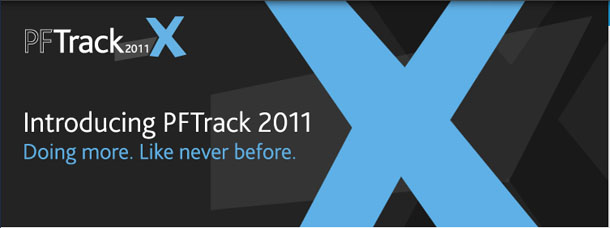PFTrack 2011 ships
The Pixel Farm has released a new version of its top-of-the-range camera-tracking software that it claims will “revolutionise matchmoving”.
PFTrack 2011 overhauls the software in a number of significant ways, adopting the node-based workflow seen in its sister products; introducing a redesigned 64-bit, GPU-accelerated core; and enhancing its tools for tracking deformable objects, as required for facial tracking.
A true revolution in tracking, or simply the continued evolution of an already-powerful tool? Read the release notes below, and judge for yourself.
PRESS RELEASE (Excerpts)
The Pixel Farm, developer of innovative image-processing systems for VFX, DI and restoration, today announced the immediate availability of a completely redesigned version of their industry-leading 3D camera tracking and matchmoving application, PFTrack 2011.
PFTrack 2011 brings innovative solutions to the diverse challenges of advanced matchmoving faced by independent artists and large visual effects teams working within complex creative pipelines. From extensive plate preparation tools and renowned lens distortion management, through enhanced single-camera, stereoscopic camera, and geometry-based camera and object tracking, image-based modelling and scene reconstruction, PFTrack 2011 sets a new benchmark as the most comprehensive toolset available, with unprecedented levels of power, precision, flexibility and control over every aspect of the matchmoving process.
Now featuring The Pixel Farm’s distinctive node-based flowgraph architecture, PFTrack 2011 introduces revolutionary approaches to camera and object motion calibration, scene preparation, project management and data flow, opening new doors to how the information generated by matchmoving can be utilized and exploited facility-wide. With fully-integrated Python scripting and workflow customization tools, facilities can access the underlying metadata management core of PFTrack 2011 and tightly integrate the software into their own unique workflow.
PFTrack 2011 has been completely re-written as a 64-bit, GPU-accelerated application and expands the robust capabilities of PFMatchit (introduced at Siggraph 2010) by adding a comprehensive suite of advanced matchmoving, scene preparation and image processing tools.
The acclaimed Geometry Tracking functionality of PFTrack has been enhanced to support tracking of deformable objects, such as an actor’s face while speaking, in addition to solving camera and rigid object motions. Since the track is accomplished using the tracking geometry’s vertices as opposed to point or pattern trackers, Geometry Tracking in PFTrack 2011 conquers many of the typical pitfalls that plague conventional tracking operations such as glints and highlights. Image Modelling and Texture Extraction nodes generate detailed geometry for scene fitting, shadow boxing, and set reconstruction. A set of modelling primitives can be positioned in 3D space and edited to match the image data, or new models can be constructed. Per-pixel Z-Depth extraction now supports masks, used to specify the relative depth ordering of objects in the scene, producing a grey-scale depth map image and triangular mesh geometry. Reengineered Optical Flow tools calculate dense optical flow fields describing the apparent motion of objects relative to the camera plane, and features retiming of clip and motion data to increase or decrease the apparent frame-rate of the camera. Retiming after a camera solve will also retime the camera solution, meaning shots do not require a re-tracking do to editorial decisions later in post production.
Pricing and availability
PFTrack 2011 is available today and retails for $3,300 USD.

